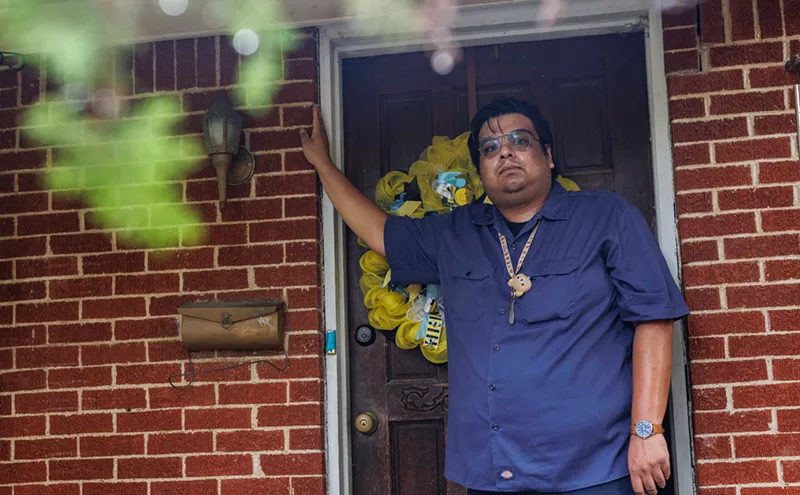Last Wednesday brought a dose of positive news for anyone concerned about Texas' sky-high teen birth rate, which given that it costs the state an estimated $1.1 billion per year and puts Texas in the company of such bastions of progressive public-health policy as Mississippi, Arkansas and Oklahoma, should be everyone. According to The Dallas Morning News, the state-run Healthy Texas Women program will provide low-income teenagers with access to free birth control. In another hopeful sign, the U.S. Department of Health and Human Services awarded a $4.9 million grant to a coalition of local nonprofits, researchers and healthcare providers to combat teen pregnancy in five Dallas ZIP codes that have stubbornly defied the national decline in teen pregnancy, where as many as one in nine girls aged 15-19 has given birth.
Expanding access to contraception and improving education, as these new initiatives do, are hardly groundbreaking techniques in the fight against unintended pregnancy. Then again, Texas doesn't have to break any new ground in order to lower its embarrassingly high teen pregnancy rate. There are plenty of tried-and-true methods that Texas can pull off the shelf if and when it decides to. It could, for instance, simply follow the lead of California, which used to be neck-and-neck with Texas on teen pregnancy. But California has reduced its pregnancy rate by two-thirds, about twice as fast as Texas, and is now right at the national average. If Texas is serious about doing the same, experts say, it needs to improve in the following areas:
Sex Education
Twenty-two states and the District of Columbia require schools to offer sex education. Thirty-three and D.C. require HIV education. Texas, which tends to defer to parents on these matters, is on neither list. This means many kids in Texas are getting no sex ed at all, which, research shows, is a pretty big problem if one wants kids to stop getting pregnant. Good sex-ed programs have been proven to delay the initiation of sex, reduce the frequency and number of partners and increase the use of contraception, all of which are potent pregnancy-fighting techniques. "It's proven the more kids know the less they do," says Terry Greenberg, executive director of the North Texas Alliance to Reduce Teen Pregnancy.
To be sure, many Texas kids are taught sex ed in school, but that doesn't help as much as it should because the sex ed that's taught in Texas public schools is garbage. Most of it is abstinence-only, which by definition omits mention of contraceptives and birth control. A growing number of districts have adopted "abstinence-plus," which touts abstinence as teens' first and best choice, as Texas law requires, but also mentions contraceptives, though with heavy stress on their failure rate. Abstinence-focused education doesn't have to be awful. Mandy Golman, a professor at Texas Woman's University working with Greenberg under the federal grant, prefers comprehensive sex-ed but says that medically accurate, evidence-based abstinence education can also be effective. The CDC endorses about three dozen such programs. The problem is that few if any of the good abstinence programs are being taught in Texas.
Greenberg sees the results of Texas' sex-ed policy when she visits local universities or talks to teenagers at health fairs. On a recent visit to the University of Texas at Dallas, she was struck by how poorly informed the students — legal adults, most of them presumably sexually active — were about the basics of safe sex. At a recent health fair at the Church of the Incarnation, she recalls kids staring at her slack-jawed when she asked to talk to them about their sexual health. Soon, though, they were pulling their friends over to talk to her. Almost all of the kids she encountered that day had friends who'd been pregnant.
Encouraging abstinence is great, Greenberg says, but if human history tells us anything, it's that telling kids not to have sex doesn't work. The best thing Texas can do is require that students get comprehensive, evidence-based sex ed. A good curriculum would be part anatomy lesson, teaching kids exactly how pregnancy happens and how STDs are transmitted, and part realistic conversation about the consequences of sex. The latter should include things like goal-setting, in which students give thoughtful consideration their future and how an unintended pregnancy might affect it. The basic takeaway of a good sex-ed program, Greenberg says, is that "if you're going to make this decision, it's a really big decision, and you need to treat it as an adult."
Access to Contraception Say a teenager completes a well-designed, comprehensive sex ed curriculum and, because he or she is a teenager, decides to have sex anyway. To avoid having a baby, the teen will need some form of contraception more reliable than the pull-out method. The good news, Greenberg says, is that they can typically access low- or no-cost contraceptives at at one of Parkland Hospital's community clinics or other low-cost medical providers. The bad news is that there are a lot of other barriers.
"Right now, I think it's challenging for teens in Dallas to know where to go," says Golman. Greenberg says her coalition is working both to expand the number of places where free and low-costs contraception is offered and to develop resources to make it easier for teens, as well as health-care providers, to know where those are. That's mostly a matter of communication. The parents are trickier. Some clinics, like those run by Parkland, use federal Title X funding, which allows teenagers to access birth control without parental consent. Elsewhere, in any clinic that relies on state funds, teens must obtain parental consent. There's nothing quite like asking mom and dad to endorse premarital sex to kill one's commitment to using birth control. Texas should (but almost certainly won't) do away with the parental consent requirement.
Also important is the type of birth control that's accessed. Condoms are, in theory, a relatively effective method of birth control, with a failure rate of 2 percent. The pill is even better, with a 0.3 percent failure rate. But pills are forgotten and condoms are misapplied, which is why the real-world failure rates for those methods jumps to 18 percent and 9 percent, respectively. And teens are even worse at this stuff than adults. As this CDC infographic shows, many women who rely on the pill or condoms still get pregnant.
Long-acting reversible contraception, or LARCs, like IUDs and hormonal implants are by far the most effective available means of birth control. They are implanted once and remain effective for years, thus eliminating the element of human error that reduces the effectiveness of condoms and the pill. Slate recently published a roundup of five studies examining what happens when LARCs, coupled with information about their effectiveness, are made readily available to women. In each of the studies, researchers found that the rate of unintended pregnancies dropped dramatically. The case most frequently cited by local women's health advocates comes from Colorado. Starting in 2009, with funding from private donors, the Colorado Family Planning Initiative subsidized LARCs, trained healthcare providers in their use, and promoted them as a more effective alternative to other forms of contraception. By the end of the two-year study, LARC usage had almost quadrupled, from 5 percent to 19 percent, among women 15-24 years old. Teen pregnancy fell to 29 percent below their expected level and abortions dropped significantly.
In Texas, LARC adoption among teens remains low, with about 92 percent of teens seeking contraception opting for less effective alternatives. Texas' new initiative appears likely to include LARCs, though details are scant and it's unclear how much money the state is putting into the program or how large it will be.
Reproductive Healthcare Funding (i.e. Stop Cutting It) Texas was defunding Planned Parenthood way before those gonzo videos showing clinic personnel talking about harvesting fetal tissue made it a thing. In 2011, in order to spite Planned Parenthood, the Legislature cut the state's family planning budget by two-thirds, with predictable results. Because the nonprofit was the largest provider of reproductive health care to poor Texas women, and because the cuts forced other, smaller providers to shut down, access to birth control was significantly reduced. The Texas Women's Health Program, which ostensibly was supposed to plug the gaping hole that resulted, women's health advocates say, has yet to match the scale or effectiveness of the pre-2011 regime, of which Planned Parenthood was a major part.
The consequences of the Legislature's decision offers an obvious lesson for those wanting to reduce unintended pregnancies: stop gutting family planning and women's health programs. Following this maxim has proven remarkably difficult. Right now, U.S. Senator Ted Cruz is pushing to eliminate federal funding for Planned Parenthood at the risk of a government shutdown. Republicans in Congress are also moving, albeit with less ostentation, to slash funding for the Teen Pregnancy Prevention Program by 80 percent. Organizations in Texas, which have received about $7.4 million through the program since its inception in 2010, are worried that their funding will dry up. "All this funding we got for this year...it's not a guarantee," says Golman, referring to the $4.9 million grant that, she says, will evaporate if Congress cuts the teen pregnancy program. "It seems silly. They have something that's working."
Poverty
Golman and Greenberg know they aren't going to fix the entrenched poverty that defines the South Dallas' 75215 ZIP code, where there are 113 births each year per 1,000 girls aged 15-19, more than four times the national average. They do, however, believe that, by ameliorating some of poverty's corrosive effects, they can reduce unintended pregnancies and keep teens from becoming trapped in a situation that can extinguish a promising future.
Maybe teens In South Dallas and the four other ZIP codes being targeted under the federal grant have more sex than their counterparts in, say, the Park Cities, where teen pregnancy is virtually nonexistent. But Greenberg doubts it. For one, she expects that kids in Highland Park tend to be better educated about birth control and where to get it than less affluent peers. Greenberg attended Hockaday, the elite all-girls prep school in North Dallas, which she says offered "great sex education. People there knew we had futures to protect." That's the other piece. Because the future can seem bleak for kids raised in desperate poverty, and because they are surrounded by other teen parents, getting knocked up at 15 might not seem so catastrophic.
In the targeted ZIP codes, "pregnancy is a social norm," Golman says. Teen parents have kids who themselves become teen parents. Kids babysit the children of their siblings. Girls with swollen bellies walk the halls at school. Given the other challenges of poverty, "having a baby in the context of their lives may not be the worst thing that happens to them," Greenberg says. So it's not enough to make birth control freely available, and it's not enough to make sure kids know about it. It's also necessary to convince them that they, like the girls at Hockaday, have futures to protect. That's easier said than done. as it requires a recalibration of cultural attitudes, but progress is possible. "It takes a village to raise a child, but it's also going to take a village to prevent a child from having a child," Golman says.
Parents
When Greenberg's son, now 21, was a teenager in Richardson ISD, she flipped through his health book and was dismayed to find approximately one mention of condoms and none of the evidence-based sex education she has come to preach. The discovery set her on the path that would lead her to become a prominent advocate of comprehensive sex ed and CEO of a nonprofit battling teen pregnancy, but at the time her immediate concern was that her son understand sex and its potential consequences. So she sat him down and talked with him in granular detail. "I don't think parents want to explain about anal or oral sex. It's a conversation I had with my kids and they did not enjoy it."
Most parents aren't like Greenberg. Either because they don't feel comfortable talking with their kids about sex or because they don't appreciate the need for discussion, they leave education up to school teachers and peers. That, Greenberg says, is a mistake. "Parents are the kids first portal for this information," she says. Kids who get The Talk from their parents — not an awkward birds-and-bees metaphor but a real, factual discussion — tend to delay sexual activity, if for no other reason than the noted libido-killing effect of hearing one's mom or dad mention "sex." The federal grant will fund a program, Families Talking Together, that will teach parents how and why to discuss sex with their kids. The program has proven to be effective but, again, the scope of the grant is limited. To make a dent in the teen-pregnancy rate, such programs will have to be put in place on a wider scale.

Audio By Carbonatix
[
{
"name": "GPT - Billboard - Slot Inline - Content - Labeled - No Desktop",
"component": "21721571",
"insertPoint": "2",
"requiredCountToDisplay": "2"
},{
"name": "STN Player - Float - Mobile Only ",
"component": "21861991",
"insertPoint": "2",
"requiredCountToDisplay": "2"
},{
"name": "Editor Picks",
"component": "17105533",
"insertPoint": "4",
"requiredCountToDisplay": "1"
},{
"name": "Inline Links",
"component": "18349797",
"insertPoint": "8th",
"startingPoint": 8,
"requiredCountToDisplay": "7",
"maxInsertions": 25
},{
"name": "GPT - 2x Rectangles Desktop, Tower on Mobile - Labeled",
"component": "22608066",
"insertPoint": "8th",
"startingPoint": 8,
"requiredCountToDisplay": "7",
"maxInsertions": 25
},{
"name": "Inline Links",
"component": "18349797",
"insertPoint": "8th",
"startingPoint": 12,
"requiredCountToDisplay": "11",
"maxInsertions": 25
},{
"name": "GPT - Leaderboard to Tower - Slot Auto-select - Labeled",
"component": "17357520",
"insertPoint": "8th",
"startingPoint": 12,
"requiredCountToDisplay": "11",
"maxInsertions": 25
}
]











